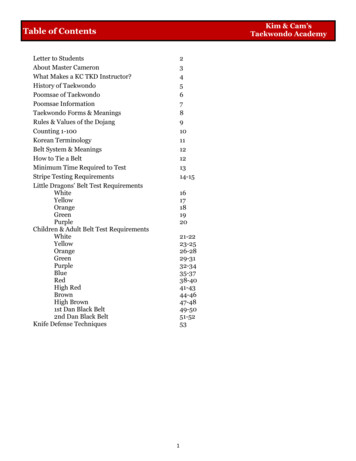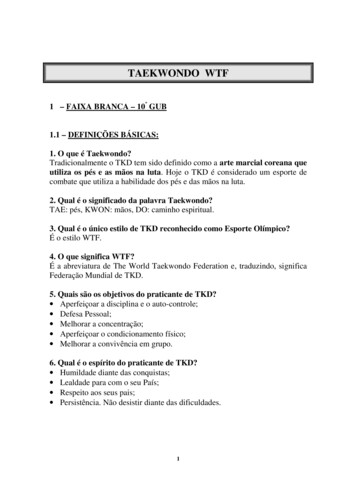
Transcription
STUDENTHANDBOOKPage 1 of 36
Welcome to Collierville TaekwondoWhat have I signed up for?We are teaching the traditional Korean martial art called Taekwondo, both traditional and sport forms.More importantly, this is a WTF school, i.e. the World Taekwondo Federation. The WTF is the largestfederation in the world and growing. It is the only federation allowed to participate in the Olympic Games.You have enrolled in a school with an established curriculum and highly ranked, seasoned instructors.Unlike most sports or gym memberships, this is a serious educational process, very much like earninga 4-year college degree. Your long term goal is Black Belt. Your short term goal is the next rank orcolor belt in succession. The curriculum will focus you and prepare you for each rank promotion, stepby-step towards the black belt. You will be tested every 2 to 3 months for a new belt.What are the benefits?Taekwondo has many benefits--mental and physical. Mentally we are teaching focus, positive attitude,respect, discipline, manners, confidence, perseverance and self-control. Physically we are helping youimprove your flexibility, balance, speed, coordination and endurance as well as self-defense.What is the order of the ranks(belts) up to Black eBlueBlue IIBrownBrown II10.11.12.13.14.15.16.17.18.RedRed IIRed/BlackBlack/RedRecommended Black BeltRecommended Black Belt IRecommended Black Belt IIRecommended Black Belt III1st Degree Black BeltHow long does it take to achieve Black Belt?With consistent training and very few breaks, you could earn your 1st degree black belt in 3 years. Mostpeople take 3 ½ to 4 years as this an educational process, not a race.Will my Black Belt be accredited and recognized?Yes! We are a fully accredited school under the sanction of The Kukkiwon, which is headquarters ofthe World Taekwondo Federation based in Seoul, Korea. Upon achieving your black belt you willreceive a WTF certificate of accreditation that comes from The Kukkiwon as well as a laminated ID card.Your name and rank will go into their data base. No one can ever deny your rank or take thisachievement away from you. It will be honored by any Kukkiwon sanctioned school in the world.Now you can begin your journey to black belt and experience the benefits of the martial arts without anyconcerns about your path and the quality of its design and instruction. We will do everything in ourpower to help you along the way, and we hope you overcome the odds and achieve what most peoplecannot—Black Belt.Page 2 of 36
History of TaekwondoTaekwondo is a distinctly Korean art with a long and interesting history. Taekwondo began morethan 2000 years ago, around 50 B. C. This is documented by murals found on the walls of anancient royal tomb in Korea called the Muyong-Chong. The murals depicted people practicingTaekwondo stances, blocks and punches. In those times, secret military forces used Taekwondo.Evidence shows that since its inception, Taekwondo was practiced both as a sport and as a wayof self-defense.In ancient times, Korea was divided into three Kingdoms: Silla, Koguryu and Baekche. Taekwondofirst began in the Koguryo kingdom. However, Silla unified the kingdoms and was most influentialin the advancement of the art. King Jin Heung established a military, educational and socialorganization called the Hwa Rang Do. The Hwa Rang Do consisted of youths of noble familiesdevoted to cultivating mind and body in order to better serve Silla. The martial spirit representedby the Hwa Rang Do became the root of Silla's nation 66l? morality and strength. They followeda code of honor comprised of rigid loyalty to the nation, respect and obedience to their parents,unswerving loyalty to friends, courage in battle, and prudence on the use of force. This code ofhonor remains the philosophical backbone of the Korean Martial Arts even to this day! In additionto advocating the study of unarmed combat as a part of physical military training, the Hwa RangDo also recommended it as a recreational activity.During the Koryo dynasty (935AD—1392AD), the study of unarmed combat, then known asSoobak, reached its greatest early popularity. The study of Soobak was supported by the royalfamily and those skilled in the art were often favorably considered for promotion in the military orcivil service. From the end of this kingdom to around the twentieth century, unarmed combatexperienced a decline as Confucian ideas became more popular. Confucian thinking stated only"inferior men" engaged in strenuous activities such as the martial arts.In 1909 Japan conquered Korea and forbade the practice of martial arts. However, martial artswent underground and was practiced secretly throughout the country. When liberated in 1945, thepopularity of Taekwondo, then known as Tae Kyon, exploded into the open. However, because ofthe Tae Kyon had been practiced secretly for so long by hundreds of small groups, many differentstyles had developed. In the early 1960’s, after years of discussion, most instructors were able toagree on a unified style called Taekwondo.Today, people all over the world are discovering the benefits of Taekwondo training. It is recognizedas the most popular martial art in the world. Taekwondo has been an Olympic demonstration sportsince 1988 and began as an official event in the 2000 Olympics. It is the World TaekwondoFederation that has been mainly responsible for the growth of the martial art and continues to bethe primary source of its education and leadership. Headquarters of the WTF are located in Seoul,Korea at The Kukkiwon, which means “The Institute for a National Sport.”Page 3 of 36
Philosophy of TaekwondoTAE KWON DO means “two feet, two hands, one mind” martial art. From Taekwondo's ancientbeginnings to the modern day, Its purpose has remained unchanged—To serve as a way ofphysical and mental training which will forge a healthy body and a clear mind. Hence, it is a systemof both self-defense and exercise. The practice of Taekwondo improves characteristics suchas strength, speed, coordination, flexibility, power and balance. These attributes relate to thebody. Taekwondo enhances mental and spiritual qualities by teaching discipline, confidence,respect, patience, manners, concentration, attitude, and self-control. All these attributes arerelated to the mind. To be a complete Martial Artist one must possess the ability to control themind and the body as one.Student OathSIR, I shall observe the tenets of Taekwondo.I shall respect my instructors and seniors.I shall never misuse Taekwondo.I shall be a champion of freedom and justice.I shall build a more peaceful world, SIR.5 Tenants of Indomitable SpiritPage 4 of 36
House RulesAttendance PolicyThe best way for you to achieve the benefits of Taekwondo is to attend class consistently.Coming to class two or three time each week should allow you to see the progress and resultsthat you desire. In order for us to help you achieve the benefits you are looking for we have anattendance and progress card system. 16 Classes and two months of training are required inorder to test for your next rank.RestroomsThere are separate men and women's changing rooms. The restrooms are located at the back ofthe school.Holiday ScheduleWe are closed most federal and national holidays. There is an announcement board on the wallthat lists all closing and schedule changes at least two weeks prior to the event. Please call oremail the school if you ever have a question regarding whether or not we will be o p e n .Belt PromotionsAll students must wear their uniform tops and not their T-shirts. Remember to turn your testingapplications in at least 2 days before your test day. Make sure to show up15--30 minutesbefore your test time.GOOD LUCK TO EVERYONE AND REMEMBER TO DO YOUR BEST!Dress CodePlease wear a clean and neat, school issued uniform for every class. You may wear a school Tshirt in place of your traditional uniform top. Testing days require full traditional Uniforms.Uniforms and safety gear pads should be washed regularly. Belts should not be washed. Forsafety reasons, no jewelry or chewing gum will be allowed in class.Page 5 of 36
Respect for Uniforms and BeltsThe Taekwondo uniform is to be worn with pride. Students should make a great effort to weartheir DOBOK only for classes and demonstrations. Uniforms should always be clean andwrinkle free for each class. Belts are not to be washed.Respect for Ongoing classesWe welcome your family members and guests. However, because it is our goal toprovide the absolute best individual instruction on the training mat, we ask for "librarylike" conditions in the front lobby, and lowered voice when you are waiting for your classtostarrt Donotblock the DOJANG door when Students exit the room.Respect for School PropertyA Taekwondo school is shared by its members. Hence, the condition of the classroom,locker room, training equipment and restrooms should represent the pride we take in our artand quality of our school. While our school is cleaned regularly, all members are asked toavoid any unnecessary messes or damage.Progress CardAt the beginning of the class find your progress card in the card rack and present it to anavailable instructor. This the record of your attendance and progress. In order to test for thenext rank, you must have all your stars and stripes and attendance holes punched.Stripe Review30 days after your rank test we will do a stripe review (progress check) to make sure you areon your way, progress wise and attendance wise, to achieving your next rank. You willreceive a white stripe for attendance (8 classes) and a colored stripe of your next belt color forprogress on your assigned techniques. The week before the test we will do another stripereview to make sure you have the required attendance (16 classes) and have completed yourassigned techniques. You will be given a black stripe which confirms you are ready for theupcoming test.Membership CancellationMembership Cancellation requires 30 days written notice and a brief meeting with themanagement explaining the reason for cancellation. Examples of reasonable cancellations aremoving 20 miles or more away from the school, physically unable to continue your training, andfinancial concerns. It is in your best interest to communicate with us as we are reasonablepeople who will help you resolve this matter.Page 6 of 36
School EtiquetteBow each time you enter or exit the practice area to show respect for your instructor andfellow students.Address your instructors and all black belts as sir or ma'am. answer all questions with"Yes, Sir", "Yes, Ma'am", "No, Sir", "No, Ma'am".When training during the class always walk behind fellow students never crossing in front of them out respect if atall possible.Pay very close attention in every class and focus your attention and concentration asdirected by your instructorPlease find your progress card in the card holder and present it to any instructor beforethe class begins.Trim all toenails and fingernails to insure safety in your partner drills; wear a clean uniformon a clean body as a courtesy to the other students.Bring your sparring equipment only on designated sparring days and put your name onevery piece.All students will conduct themselves in a respectable manner outside of the school toprotect themselves, their family, or the weak.No jewelry or chewing gum will be allowed in class.No profanity is allowed around the school, whether in training or not.No one will enter the school under the influence of alcohol or drugs.Do not place your belt, that you've spent so much energy earning on the floor and ground.Your belt represents the respect that you've earned.Black Belt"Signifies maturity and proficiency in Taekwondo"The dawn of a new day. The sun breaks through thedarkness. The previous day has ended giving way toa new dawn. The student must begin a new phase oftraining, that of being a black belt.Page 7 of 36
Bowing and Its PurposeBowing is the form of body language in Korea. A bow can be used to say "hello", "goodbye", "thank you", or "your welcome". Bowing is also a way of showing courtesy andacceptance. When two people bow to each other they are showing mutual respect.Traditionally, Taekwondo students demonstrate respect by bowing to the flags beforeentering or leaving the training floor, to the instructors, to senior belts at the beginning andend of class and to a partner before and after each interaction.It is a part of Taekwondo to bow whenever and wherever you see each other. Overtime,you will find that bowing has become a natural form of expressing the special relationshipyou have with your fellow Taekwondo instructor, student, and partner.Bowing is like a handshake, a shared expression.'1Students learn that to earn respect and to give respect are verymuch the same thing.An old saying: "When in doubt, bow!"How to Bow1.2.3.4.5.The student stands at attention, head up, shoulders down, back straight, relaxed.Both feet are together, the heels are touching, and the toes are pointing straightThe hands should be held straight at the sides of the body.Bend the head down to 45 degree angle and bend deeply at the waist.When bowing, one's eyes look downward.Page 8 of 36
Sparring DrillsWhite Belt SetJab, Front Leg Front Snap Kick, Jab/PunchYellow Belt SetJab, Front Leg Round House Kick, Jab/PunchOrange Belt SetJab, Front leg Side Kick, Jab/PunchGreen Belt SetJab, Back leg half Round House kick, Jab/PunchPurple Belt SetJab, Back leg Front Kick & Side kick, Jab/PunchBlue Belt SetJab, Back Leg Half Round House Kick/Skipping Round House Kick, Jab/punchBrown Belt SetJab, Back leg Half Round Kick/Axe kick, Jab/punchRed SetJab, Bag leg Half Round Kick/Back Thrust kick, Jab/punchRed/Black SetJab, Back leg Half Round House Kick/Spinning Hook kick/Jab/punchPage 9 of 36
Self DefenseBeginnerWhite Belt1. Same-Side Wrist Grip Escape2. Cross Wrist Grip EscapeYellow Belt3. Same-Side Wrist Grip Escape with Knife-hand Strike4. Cross Wrist Grip Escape with Knife-hand StrikeOrange Belt5. Same-Side Wrist Grip into an Arm Bar (Move your hand from inside to out in a circularfashion. With your free hand grab the opponent’s wrist with your free hand. Then withthe arm you released press against your opponent’s elbow with your elbow.)6. Same-Side Wrist Grip into a Wrist Lock (Move your hand from outside to in in acircular fashion until your hand is 180 degrees from where it was originally. Usingyour free hand grab the opponent’s wrist as deeply as possible and pull your wristout of their grip. After that, with the escaped wrist, press down on the opponent’sknuckles.)Green Belt7. Cross Wrist Grip into a Shoulder Lock (When you are in a cross grip, grab theopponent’s wrist with your free hand. Pull your hand slightly pull towards yourself.Then if they resist by pulling back, then step forward and by lifting their arm and gounder it get to their back and put them into a shoulder lock.)8. Adding to #7, you put the opponent into a guillotine choke and kick Behind their kneein order to make them fall.Page 10 of 36
Self DefenseIntermediate and AdvancedPurple Belt9. Double Wrist Grip Escape (With one of your hands, quickly grab the opponent’s wristfreeing your other hand, Then with your free arm snap it against you opponent’s elbow.)10. Cross Grip into a Chicken Wing (Grab your opponent’s wrist with both of your hands.Move your outside foot in and lift up the arm that you’re holding and go under it and pullit.)Blue Belt11. Upper-Double Grip Escape with Fingertip Strike (Targeting Eyes) and Front Snap Kick(To the Groin)12. Upper-Double Grip Escape with Fingertip Strike (Targeting Throat) and Front Snap Kick(To the Groin)Brown Belt13. Major Outer Reaping Throw14. Major Hip Throw15. One-Arm Shoulder ThrowRed Belt16. Blocking against a High-Section Punch and countering with Major Outer ReapingThrow17. Blocking against a High-Section Punch and countering with Major Hip ThrowRed/Black Belt18. Counter against Someone Grabbing you from Behind #1: Squat and spread your armsand legs out. Then grab and pull their leg between your legs in order for them to fall.Then execute a heel kick to their groin.19. Counter against Someone Grabbing you from Behind #2: Squat and stretch your rightleg out slightly; then execute a One-Arm Shoulder Throw.Page 11 of 36
Korean TerminologySchool Do JangUniform Do BokBelt DeeMaster Instructor Sah Bum NimGrand Master Instructor Kwan Jang NimSparring KyoroogiSelf Defense Ho Shin SoolAttention Cha RyutBow Jung YaeBegin Si ChakAt Ease She UhSwitch Feet Bal Bah GwuhBreaking Kyuk PahFist Joo MokWrist Pal MokReverse Bahn DaeBlock MakgiKick ChagiJump Dwe UhSingle Hanh BunDouble Doo BunTriple Sae BunThank You Gahm Sah Hahm Ni DaHow Are You? Ahn Yeong Ha Shim NikaHello Ahn Yeong Ha Sae OhStrikesPunch Jee RoogiMiddle Section Punch Mom Tong Jee RoogiLow Punch Arae Jee RoogiHigh Punch Ul Gool Jee RoogiSpear Finger Thrust Soon Goot Jee RoogiKnife Hand Strike Sohn Nal Chee GiPalm Heel Strike Bah Tang Sohn Chee GiSide Punch Yup Joo MokBack Fist Deung Joo MokHammer Fist Mae Joo MokTiger Mouth Strike Ah Gum Sohn (Black Belts only)Palm Heel Strike Ba Tang Sohn Chee Gi (Black Belts Only)Knife hand High Block With Reverse Knife hand Strike Jebi Poem MokChee GiStancesHorse Back Stance Ki MajasaeReady Stance Joon BeeWalking Stance Ap sugiFront Stance Ap cubiBack Stance Dwe CubiCross Stance Koh ah SugiTiger Stance Bum SugiCrane Stance Hakdari SugiPushing Hands Ready stance Tongmilgi Joon BeeKicksFront Stretch Kick Ap Cha OlegiFront Snap Kick Ap ChagiSide Kick Yup ChagiCrescent Kick Bahn Dal ChagiRound House Kick Dol Yuh ChagiBack Thrust Kick Dwe ChagiSpin Hook Kick Dwe Dol Yuh ChagiFront Hook kick Ap Bal Dwe Dol Yuh ChagiAxe Kick Nae Ree uh ChagiJumping Front Snap Kick Dwi Uh ChagiBlocksLow Block Ah Rae MakgiMiddle Block Mome Tong MakgiHigh Block Ul Gool MakgiWedge Block Hetchuh MakgiScissor Block Kah Wee MakgiPalm Block Ba Tang Sohn MakgiSingle Mountain Block Weh Sanh TeulSingle Knife Hand Middle Block Hahn Sohn Nal Mome Tong MakgiDouble Knife Hand Middle Block Doo Sohn Nal Mome Tong MakgiX Block Uh Guh Uh MakgiMountain Block San Teul Makgi (Black Belt Only)Page 12 of 36
SPECIFIC PROMOTION REQUIRMENTSWhite Belt - Minimum 16 Classes with a 2 month DurationKi-Cho – Beginner formMeaning of Ki Cho: FoundationDemonstrate Attention; At-Ease; Ready; As you wereChambers/Blocks Low Block; High BlockStrikes Jab; PunchStances Horse Back; Forward; Kicking; ReadyKicks/Foot Work Front Stretch Kick, Front Snap Kick; Roundhouse Kick; Scissor run;Ki-Cho Poomsae Moves 1-16Sparring Set Jab, Front Leg Front Snap Kick, Jab Then PunchSelf-Defense Numbers 1 & 2Memorize and be able to recite these below: Pledge of Allegiance Charyot (Attention) Kyung-Yae (Bow) Joonbi (Ready Stance) Why do we Bow? (To show respect) Which country did Taekwondo originate from? (Korea)Page 13 of 36
Yellow Belt - Minimum 16 Classes with a 2 month DurationTaegeuk 1 (IL) JangKeon - Symbolizes heaven: the spirit of solid foundationChambers/Blocks/ Strikes Reverse Middle Block Combination High Block then Reverse Middle Punch Combination Low Block then Reverse Middle PunchStances Forward; WalkingKicks Skipping Roundhouse Skipping Side Kick Jumping Front Snap KickTaegeuk Form 1 (IL) Jang Moves 1-18Sparring Set Jab, Front Leg Round House Kick, Jab Then PunchSelf-DefenseNumbers 3 & 4Board Break Hammer Fist (not required for promotion)Memorize and be able to recite these terms below: Front Stance (Ap Cubi)Walking Stance (Ap Sugi)Block (Mahki)Kick (Chagi)Korean (Numbers1-10)Student Oath Tenets Of TaekwondoPage 14 of 36
Taegeuk Form 1 – IL JangACTUAL PATTERN SHAPE OF TAEGEUK FORMSPage 15 of 36
Orange Belt - Minimum 16 Classes with a 2 month DurationTaegeuk 2 (Ee) Jang:Tae - Symbolizes River: inner strength and external.Chambers/Blocks/ Strikes Combination High Block Then Reveres High PunchCombination Reverse Middle Block Then Middle PunchCombination Low Block Then Reverse High PunchStances ForwardWalkingKicks & Combination Kicks Axe KickCombination Front Snap Kick, Then Roundhouse KickTaegeuk 2 (Ee) Jang Moves 1-23Sparring Set Jab, Front Leg Side Kick, Jab and PunchSelf Defense Numbers 5 & 6Board Break Skipping Side Kick (Not Required for Promotion)Memorize and be able to recite these terms below: Walking Stance (Ap Sugi)Front Snap Kick (Ap Chagi)Axe Kick (Nae Ruh Chaggii)High Block (Uhl Gool Makgi)Low Block (Arae Makgi)Reverse (Bondae)What does Tae Kwon Do mean? (“Two Hands, Two Feet, One Mind” Martial Art) What is Courtesy?Page 16 of 36
Tae Geuk 2 - Ee JangPage 17 of 36
Green Belt - Minimum 16 Classes with a 2 month DurationTaegeuk 3 (Sahm) Jang:Yi - Symbolizes fire: the spirit of enthusiasmChambers, Blocks & Strikes Reverse Knife Hand Strike Single Knife Middle Block Single Knife Hand Middle Block & Reverse PunchStances Forward Walking Back StanceKicks/Foot Work Combo’s: Roundhouse Kick/Axe Kick , Back Thrust KickTaegeuk 3 (Sahm) Jang Steps 1 - 34Sparring Set (Jab, Back Leg Half Round House Kick, Jab/Punch)Self Defense Numbers 7 and 8Board Breaking Inward Knife Hand Strike (not required for promotion)Memorize and be able to recite these terms below: What is Integrity?Single Knife Hand Middle Block (Hahn Sohn Nal Mome Tong Makgi)Knife Hand Strike (Sohn Nal Mok Cheegi)Middle Block (Mome Tong Makgi)Reverse Punch (Bahn Dae Jee Roo Gi)Round House Kick (Dol Yuh Chagi)Back Thrust kick (Dwe Chagi)Back Stance (Dwe Cubi)Page 18 of 36
Page 19 of 36
Purple Belt - Minimum 16 Classes with a 2 month DurationTaegeuk 4 (Sah) Jang:Jin - Symbolize thunder: the spirit of the undeniable.Chambers, Blocks &Strikes Double Knife Hand Middle BlockSpear Finger ThrustKnife Hand High Block with Reverse Knife Hand Strike,BackfistStances Forward;Walking; BackStance Combination Round House and Skipping Roundhouse Kick/Side KickSkipping Hook KickKicksTaegeuk 4 (Sah) Jang Moves 1-29Sparring Set Jab, Back Leg Front Kick then back leg Side Kick, Jab and PunchSelf Defense Numbers 9 and 10Board Break Front Snap Kick (not required for rank promotion)Memorize and be able to recite these terms: What is Perseverance? Never Giving Up regardless of the circumstances.Knife hand High Block with reverse knife hand strike (Jae Bee Poem Mok Chee Gi) Spear Finger Thrust (Soon Goot jee rugi) Double Knife hand Middle Block (Doh Son Nile Mome Tong Maki)Back Fist ( Dung Ju Mok)Side Kick (Yup Chagi)Skipping Hook Kick ( Ap Bal Dwe Doi Yuh Chaggi)Page 20 of 36
Page 21 of 36
Blue Belt - Minimum 32 Classes with a 4 month DurationTaegeuk 5 (Oh) Jang:Sohn – Symbolizes wind: the spirit of gentle.BLUE I – 16 ClassesChambers, Blocks & Strikes Low Block with Reverse MiddleBlockBack Fist with reverse MiddleBlock;Elbow StrikeReverse Elbow Strike BLUE II – 16 ClassesChambers, Blocks & Strikes Stances Cross StanceSpinning Hook KickRoundhouse Kick/Spinning Hook KickTaegeuk 5 (Oh) Jang Low Block with Reverse MiddleBlockBack Fist with reverse Middle BlockElbow StrikeReverse Elbow StrikeStancesKicks School (Do Jang)Belt (Dee)What is Self Control?Moves 1-13 Cross StanceKicks Spinning Hook KickRoundhouse Kick/Spinning Hook KickTaegeuk 5 (Oh) JangSparring Set Jab, Back Leg Half Round HouseKick, Skipping Half Round Kick, Jaband PunchSelf Defense Back Thrust Kick (not required forpromotion)Memorize and be able to recite these terms: Moves 14-32Sparring Set Numbers 11 & 12Board Breaking Jab, Back Leg Half Round HouseKick, Skipping Half Round Kick, Jaband PunchSelf Defense Numbers 11 & 12Board Breaking Back Thrust Kick (not required)Cross Stance (Koh Ah Sugi)Elbow Strike (Palkyup Cheegi)Spinning Hook (Dwe Dol Yuh Chagi)Uniform (Do Bok)Page 22 of 36
Page 23 of 36
Brown Belt - Minimum 16 Classes with a 2 month DurationTaegeuk 6 (Yook) Jang:Gahm - Symbolizes water: the spirit of flow and ultimate flexibility.Brown I – 16 ClassesBrown II – 16 ClassesChambers, Blocks & Strikes Reverse Knife Hand sweeping Block,Outer Forearm Middle Block, Palm Press Middle BlockChambers, Blocks & Strikes Reverse Knife Hand sweeping Block,Outer Forearm Middle Block, Palm Press Middle BlockStancesBack Stance,Cross StanceStancesBack Stance,Cross StanceKicks Combination Round Kick, then AxeKick, then Back Thrust KickKicks Combination Round Kick, then AxeKick, then Back Thrust KickTaegeuk 6 (Yook) Jang Moves 1-17Taegeuk 6 (Yook) Jang Moves 18-32Sparring Set Jab, Back Leg Front Kick then AxeKick, Jab then PunchSparring Set Jab, Back Leg Front Kick then AxeKick, Jab then PunchSelf Defense Numbers 13, 14 and 15Self Defense Numbers 13, 14 and 15Board Break Starts at this Rank Jumping Front Snap Kick (Required)Board Breaking Starts at this Rank Jumping Front Snap Kick(required)Memorize and be able to recite these terms below: Reverse Knife Sweeping Block – (Son Nal Hetche Makki)Palm Heel Block – (Ba Tang Sohn Makki)Jumping Front Snap Kick (Dwe Uh Ap Chaggi)Double Punch (Doe Bohn Jee Roogi)Horse Back Stance middle section Punch (Kee Majasae Momtong Jeerugi)Breaking (Kyup Pa)Switch Feet (Pal Buh Gwuh)What is Indomitable Spirit?Page 24 of 36
Page 25 of 36
Red Belt - Minimum 32 Classes with 4 a month DurationTaegeuk 7 (Chil) Jang:Gahn – Symbolizes the mountain: the spirit of firmness and strength.RED I – 16 ClassesChambers, Blocks & Strikes Double Knife Hand Low Section BlockDouble-Forearm Middle Block (WedgeBlock)Scissor BlockDouble Upper CutCross Forearms Low Section Block (XBlock)RED II – 16 ClassesChambers, Blocks & Strikes Double Knife Hand Low Section BlockDouble-Forearm Middle Block (WedgeBlock)Scissor BlockDouble Upper CutCross Forearms Low Section Block (XBlock)Stances Tiger StanceStances Tiger StanceTaeguek 6 (Chil) Jang Moves 1-17Taeguek 6 (Chil) Jang Moves 18-33Kicks Combination Round House Kick, thenBack Thrust Kick, Then Round HouseKick,Kicks Combination Round House Kick, thenBack Thrust Kick, Then Round HouseKick,Sparring Set Jab, Back Leg Round House Kick,Then Back Thrust Kick, Then Jab andPunchSparring Set Jab, Back Leg Round House Kick,Then Back Thrust Kick, Then Jab andPunchSelf Defense Numbers 16 and 17Self Defense Numbers 16 and 17Board Break Round House KickBoard Break Round House KickMemorize and be able to recite these terms below: Scissors Block (Kah Wee Makgi)Wedge Block (Hetcha Makgi)X Block (Uh Guh Uh Makgi)Double Knife Hand Low Section Block (Doo Sohn Nal Ah Rae Makgi)Tiger Stance (Bum Sugi)Self Defense (Ho Shin Sool)What qualities of the mind are we trying to enhance in Tae Kwon Do?Page 26 of 36
Page 27 of 36
Red/Black Belt - Minimum 32 Classes with 4 month DurationTaegeuk 8 (Pal) Jang:Gon – Symbolizes the earth: the spirit of humbleness.RED/BLACK I – 16 ClassesBLACK/RED – 16 ClassesChambers, Blocks &Strikes Double Forearm Mid-Block; Single Mountain Block; Combination Single Knife hand blockthe reverse elbow strike, back fist,punch Single Upper Cut Strike;Chambers, Blocks &Strikes Double Forearm Mid-Block; Single Mountain Block; Combination Single Knife hand blockthe reverse elbow strike, back fist,punch Single Upper Cut Strike;Stances Forward Walking Back Stance Cross Stance Tiger StanceStances Forward Walking Back Stance Cross Stance Tiger StanceKicks Combination Round House Kick, ThenSpin Hook Kick, Then Round HouseKick,Kicks Combination Round House Kick, ThenSpin Hook Kick, Then Round HouseKick,Taegeuk 8 (Pal) Jang Moves 1-15Taegeuk 8 (Pal) Jang Moves 16-37Sparring SetJab, Back Leg Round House Kick, Then SpinHook Kick, then Jab and PunchSparring SetJab, Back Leg Round House Kick, Then SpinHook Kick, then Jab and PunchSelf Defense Numbers 18 and 19Self Defense Numbers 18 and 19Board Break Spinning Hook KickBoard Break Spinning Hook KickMemorise and be able to recite these terms below: Single Mountain Block ( Weh San Teul Makgi)Double Forearm Low Block (Doo Sohn nal Ah Rae Makgi)Double Forearm Middle Block (Doo Sohn nal Mome Tong Makgi)Instructor (Sah Bum Nim)Grand Master (Kwan Jang Nim)Thank You (Gahm Sah Hahm Ni Da)How are You (Ahn Yeong Ha Shim NiKa)What Qualities of the Body are we trying to enhance in Taekwondo?Page 28 of 36
Page 29 of 36
You have now begun your peperation for your black belt test. This will be a comprehensive review andrefreshing of everything you have learned since you began Taekwondo broken down into 4 stages.Recommended Black Belt 0 & I - Minimum 32 Classes with a 4 month DurationRECOMMENDEDBLACK BELT – 16 ClassesChambers, Blocks &Strikes White Belt Techniques Yellow Belt Techniques Orange Belt TechniquesStances Forward WalkingKicks White belt Kicks Yellow Belt Kicks Orange Belt KicksPoomsae Ki Cho Basic Form (White) Taegeuk 1 (Il) Jang (Yellow) Taegeuk 2 (Ee) Jang (Orange)Sparring Set White Belt Sparring Set Yellow Belt Sparring Set Orange Belt Sparring SetREDCOMMENDEDBLACK BELT I – 16 ClassesChambers, Blocks &Strikes Green Belt Techniques Purple Belt TechniquesStances Forward Walking Back StanceKicks Green Belt Kicks Purple Belt KicksPoomsae Taegeuk 3 (Sahm) Jang Taegeuk 4 (Sah) JangSparring Set Green Belt Sparring Set Purple Belt Sparring SetSelf Defense Numbers Seven Through TenSelf Defense Numbers One Through SixBoard Break One Hand & One Foot TechniqueBoard Break One hand & One Foot TechniqueTerminology Green & Purple BeltTerminology White, Yellow and Orange BeltPage 30 of 36
Recommended Black Belt II & III - Minimum 16 Classes with a 2-month DurationRECOMMENDEDBLACK BELT II – 16 ClassesChambers, Blocks &Strikes Blue Belt Techniques Brown Belt TechniquesStances Forward Walking Cross StanceKicks Blue belt Kicks Brown Belt KicksPoomsae Taegeuk 5 (Oh) Jang (Blue) Taegeuk 6 (Yuk) Jang (Brown)Sparring Set Blue Belt
History of Taekwondo Taekwondo is a distinctly Korean art with a long and interesting history. Taekwondo began more than 2000 years ago, around 50 B. C. This is documented by murals found on the walls of an ancient royal tomb in Korea called the Muyong-Chong. The murals depicted people practicin










